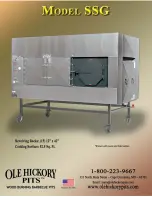
8
3. Steam will immediately begin to
release through the valve. Keep face
and hands away from steam as it is
released, and do not release pressure
under hanging cabinets, which can be
damaged by steam. When pressure is
fully released, the pressure indicator
will drop and the lid will unlock to
open. Using Quick Pressure Release
stops the pressure cooking immedi-
ately. If further cooking is necessary,
the unit may be returned to Pressure,
or the food may be further cooked on
the Simmer Setting.
4.
Combination Natural Pressure Release
and Quick Pressure Release – For
some recipes, we have chosen to use
a combination of Natural Pressure
Release and Quick Pressure Release.
Allow Natural Pressure Release for the
time indicated in the recipe (food will
continue to cook slightly) followed by
Quick Pressure Release.
WARNING: USE EXTREME CAUTION
WHEN RELEASING PRESSURE. USE
TONGS OR SIMILAR UTENSIL TO PULL
HANDLE OF PRESSURE LIMIT VALVE
FORWARD.
When the red float is completely down,
turn the lid clockwise and lift to remove.
SLOW COOKING
After Selecting Low slow or High slow
cook, press TIME to select number of half
hour needed for slow cooking. Time
increases in 30-minute increments up to
9.5hours.
Cover the cooker as directed. Turn the
pressure limit value to ‘Pressure Release’
position (see figure 6) Press menu button
and select Low or High slow cook
function.
STEAMING
Press ‘Time’ to select number of minutes
needed for steaming. Time increases in 1
minute increments. Place trivet inside
cooking pot. Add 2 cups of water. Top of
trivet should be above water.
Place steaming tray on top of the trivet.
Place food inside steaming tray, ensuring
food is evenly spaced to allow steam to
circulate.
Close and secure lid and leave the
pressure valve in the open position.
Press start.
SAFETY FEATURES
There are seven safety devices installed in
the pressure cooker to assure its
reliability.
1.
Open-and-Close Lid Safety Device
The appliance will not start
pressurizing until the lid is closed
and locked properly.
The lid cannot be opened if the
appliance is filled with pressure.
2.
Pressure Control Device
The correct pressure level is
automatically maintained during
the cooking cycle.
3.
Pressure Limit Valve
The pressure limit valve will release air
automatically when the pressure
inside exceeds the preset
temperature.
Note: Overfilling the pressure cooker
(see Instructions for Use) may clog
the pressure limit valve, which can
cause excess pressure to develop.
4.
Anti-Block Cover
Prevents any food material from
blocking the pressure limit valve.
5.
Pressure Relief Device
When the pressure cooker reaches
the maximum allowable pressure and
temperature, the cooking pot will
move down until lid separates from
the sealing ring, releasing air
pressure.
6.
Thermostat
The power will automatically shut off
when the cooking pot temperature
reaches the preset value, or the
pressure cooker is heating without
any food inside.
7.
Thermal Fuse
The circuit will be opened when the
pressure cooker reaches the
maximum temperature.





























